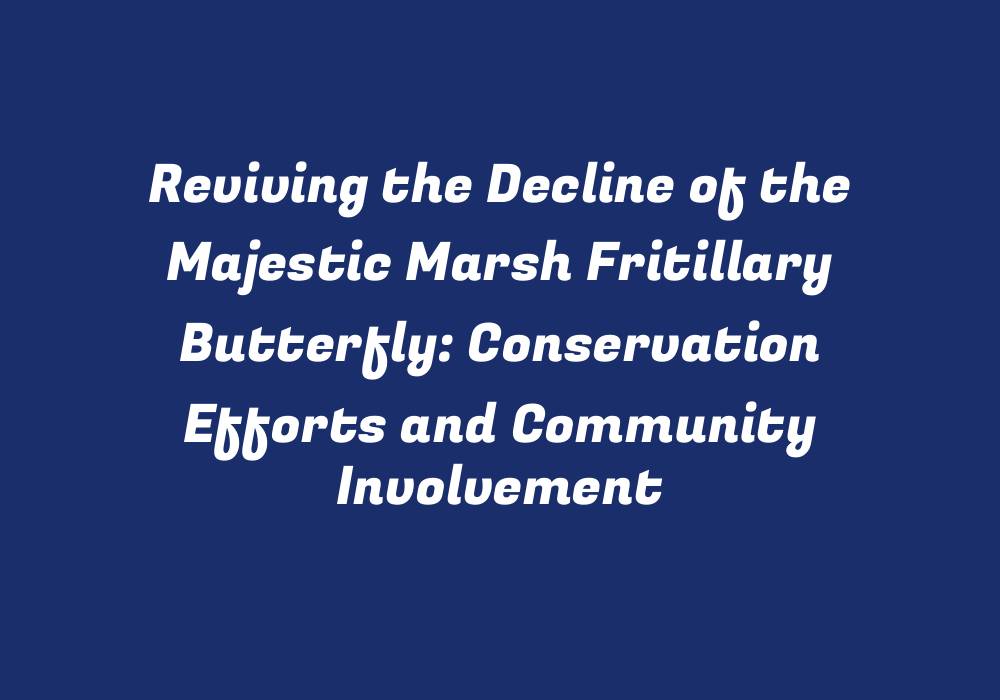Introduction: The Plight of the Marsh Fritillary Butterfly
The Marsh Fritillary butterfly has been a fascinating part of Europe’s rich wildlife for centuries. However, recent times have witnessed this once-majestic creature’s dramatic decline due to various factors, including habitat loss and destruction, climate change, and pesticide use. This decline is alarming as it could potentially lead to the disappearance of these beautiful creatures from our landscape. To counteract this crisis, a combination of conservation efforts and community involvement is needed for their revival.
Conservation Initiatives
Agricultural practices and intensive land management have severely impacted the natural habitats where Marsh Fritillary butterflies breed and thrive. Conservation initiatives are essential to ensure these insects receive the appropriate care needed for their survival. Some key strategies include:
Habitat Restoration
One of the primary methods used to safeguard the Marsh Fritillary’s habitat is restoring and enhancing its natural habitats. These efforts involve planting nectar-rich plants that attract butterflies, creating meadows and hedgerows, and reintroducing native species back into the area. By revitalizing these habitats, we provide a conducive environment for the Marsh Fritillary to reproduce, feed, and grow.
Breeding Programs
In some cases, breeding programs have been initiated to help replenish the dwindling populations. These efforts involve capturing adult butterflies during their mating season and artificially incubating their eggs in a controlled environment until they hatch. The hatched caterpillars are then reared and released back into the wild, where they contribute to the population’s growth.
Monitoring and Surveillance
To better understand the Marsh Fritillary’s decline and assess the effectiveness of conservation efforts, consistent monitoring and surveillance are crucial. This can include tracking butterfly populations, monitoring habitat quality, and studying the effects of various environmental factors on their population dynamics.
Community Involvement: A Crucial Element for Success
Involving local communities in conservation efforts is critical to the revival of the Marsh Fritillary butterfly. By engaging stakeholders and fostering a sense of ownership, it becomes easier to manage the resources needed to protect their habitats and promote sustainable practices. Some ways this can be achieved include:
Education and Awareness
Raising awareness about the Marsh Fritillary’s decline and its importance in the ecosystem is an essential step to gain support from local communities. Through educational programs, workshops, and campaigns, people can learn about the threats facing this species and understand the steps needed to mitigate those challenges.
Volunteer Opportunities
Providing volunteer opportunities in conservation efforts allows community members to actively participate in the preservation of their local ecosystem. This could include planting native plants, monitoring habitat quality, or assisting with butterfly breeding programs. By involving more people, we can create a network of passionate individuals committed to saving this beautiful species.
Collaborative Partnerships
Engaging various stakeholders – including government agencies, environmental non-profits, and local businesses – is essential for creating strong partnerships that foster conservation efforts. Through collaborations like these, we can pool resources, share expertise, and establish long-term strategies to revive the Marsh Fritillary population.
Incentivizing Sustainable Practices
By rewarding and promoting sustainable farming practices that benefit both agriculture and wildlife conservation, communities can foster a more balanced ecosystem. This includes supporting organic farming methods, using environmentally friendly pesticides, and preserving biodiversity within agricultural landscapes.
Conclusion: A Collective Effort for Survival
Reviving the decline of the majestic Marsh Fritillary butterfly demands a comprehensive approach that involves conservation efforts and community involvement. By restoring its habitats, nurturing populations through breeding programs, monitoring their status, and engaging with local communities, we can ensure this beautiful species has a chance to thrive once more in our landscapes. Through such collective endeavors, we can safeguard the future of Europe’s rich butterfly diversity and create a healthier, more sustainable environment for all living creatures.
